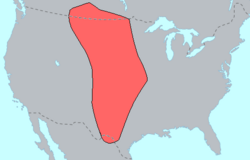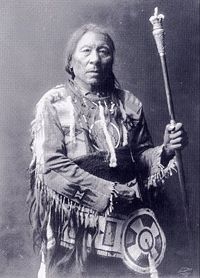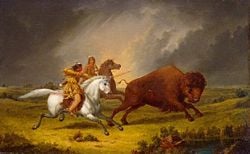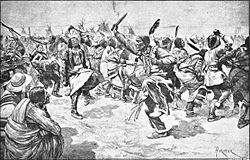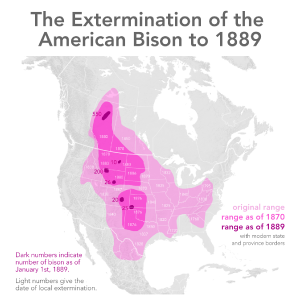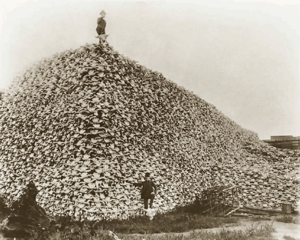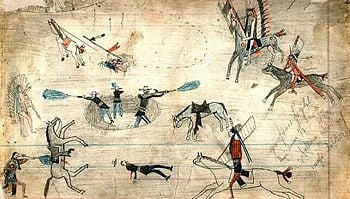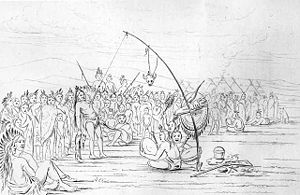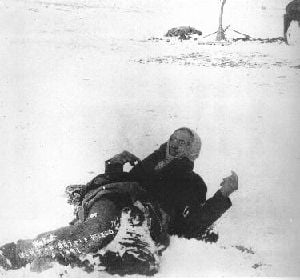Difference between revisions of "Plains Indians" - New World Encyclopedia
| Line 99: | Line 99: | ||
Another Lakota interpretation of Jack’s religion is drawn from the idea of a “renewed Earth” in which “all evil is washed away.” This Lakota interpretation included the removal of all Anglo Americans from their lands, unlike Jack’s version of the Ghost Dance which encouraged harmonious co-existence with Anglos. | Another Lakota interpretation of Jack’s religion is drawn from the idea of a “renewed Earth” in which “all evil is washed away.” This Lakota interpretation included the removal of all Anglo Americans from their lands, unlike Jack’s version of the Ghost Dance which encouraged harmonious co-existence with Anglos. | ||
| − | In February 1890, the United States government broke a Lakota treaty by adjusting the [[Great Sioux Reservation]] of [[South Dakota]] (an area that formerly encompassed the majority of the state) into five smaller reservations (Kehoe 2006). | + | In February 1890, the United States government broke a Lakota treaty by adjusting the [[Great Sioux Reservation]] of [[South Dakota]] (an area that formerly encompassed the majority of the state) into five smaller reservations (Kehoe 2006). Once on the reduced reservations, tribes were separated into family units on {{convert|320|acre|km2|sing=on}} plots, forced to farm, raise livestock, and send their children to [[Carlisle Indian School|boarding schools]] that forbade any inclusion of Native American traditional culture and language. |
To help support the Sioux during the period of transition, the [[Bureau of Indian Affairs]] (BIA), was delegated the responsibility of supplementing the Sioux with food and hiring white farmers as teachers for the people. The farming plan failed to take into account the difficulty Sioux farmers would have in trying to cultivate crops in the semi-arid region of South Dakota. By the end of the 1890 growing season, a time of intense heat and low rainfall, it was clear that the land was unable to produce substantial agricultural yields. Unfortunately, this was also the time when the government’s patience with supporting the so-called “lazy Indians” ran out, resulting in rations to the Sioux being cut in half. With the [[bison]] virtually eradicated from the plains a few years earlier, the Sioux had no options available to escape starvation. | To help support the Sioux during the period of transition, the [[Bureau of Indian Affairs]] (BIA), was delegated the responsibility of supplementing the Sioux with food and hiring white farmers as teachers for the people. The farming plan failed to take into account the difficulty Sioux farmers would have in trying to cultivate crops in the semi-arid region of South Dakota. By the end of the 1890 growing season, a time of intense heat and low rainfall, it was clear that the land was unable to produce substantial agricultural yields. Unfortunately, this was also the time when the government’s patience with supporting the so-called “lazy Indians” ran out, resulting in rations to the Sioux being cut in half. With the [[bison]] virtually eradicated from the plains a few years earlier, the Sioux had no options available to escape starvation. | ||
Revision as of 20:08, 5 November 2008
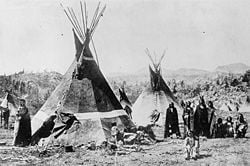
Plains Indians are usually divided into two broad classifications which overlap to some degree.
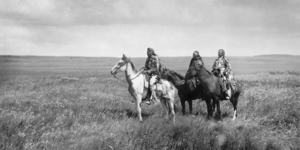
The Plains Indians are the Indigenous peoples who live on the plains and rolling hills of the Great Plains of North America.
Languages
Including a large number of different tribes, the Plains Indians spoke a variety of different languages. These include languages from the Algonquian, Siouan, Caddoan, Ute-Aztecan, Athabaskan, and Kiowa-Tanoan languages. Thus, for example, the Sioux, Crow, Omaha, Osage, Ponca, and Kansa spoke variations of the Siouan language while the Arapaho, Blackfoot, and Cheyenne spoke Algonquian languages.
Plains Indian Sign Language (PISL) is a sign language formerly used as an auxiliary interlanguage among the Plains Indians tribes. It involves the use of hand and finger positions to represent ideas. Based on their common experiences, these symbolic representations were understood by the majority of the tribes in the Plains.
In 1885, it was estimated that there were over 110,000 “sign-talking Indians,” including Blackfoot, Cheyenne, Sioux and Arapahoe. By the 1960s, there remained a “very small percentage of this number” (Tomkins 1969). There are few PISL signers alive today.
Culture
Plains Indians are usually divided into two broad classifications which overlap to some degree.[citation needed] The first group were fully nomadic, following the vast herds of bison. Some tribes occasionally engaged in agriculture—growing tobacco and corn primarily. These included the Blackfoot, Arapaho, Assiniboine, Cheyenne, Comanche, Crow, Gros Ventre, Kiowa, Lakota, Lipan, Plains Apache (or Kiowa Apache), Plains Cree, Sarsi, Sioux, Shoshone, and Tonkawa.
The second group of Plains Indians (sometimes referred to as Prairie Indians) were the semi-sedentary tribes who, in addition to hunting bison, lived in villages and raised crops. These included the Arikara, Hidatsa, Iowa, Kaw (or Kansa), Mandan, Omaha, Osage, Otoe, Pawnee, Ponca, and Wichita.
The nomadic tribes survived on hunting, and bison was their main food source. The tribes are described as part of the 'Buffalo Culture' (sometimes called, somewhat misleadingly, the 'Great Plains Culture').[citation needed] American buffalo, or simply buffalo, is the commonly used (but inaccurate) name for the American Bison. These animals were the chief source for items which Indians made from their flesh, hide and bones, such as food, cups, decorations, crafting tools, knives, and clothing. Not a single part of the animal was thrown away.
The tribes kept moving following the seasonal and grazing migration of bison. The Plains Indians created tipis because they were easily disassembled and allowed the nomadic life of following game. When escaped Spanish horses were obtained, the Plains tribes rapidly integrated them into their daily lives, wealth and hunting techniques. They fully adopted a horse culture beginning in the 17th century.[citation needed]
Hunting
Although the Indians hunted other animals, such as elk or antelope, bison was the primary game food source. Before horses were introduced, hunting was a more complicated process. The Native Americans would surround the bison, and then try to herd them off cliffs or into places where they could be more easily killed. A commonly used technique was the Piskin method.[citation needed] The tribesmen would build a corral and have people herd the buffalo into it to confine them in a space where they could be killed. The Indians constructed a v-shaped funnel, about a mile long, made of fallen trees, rocks, etc. Sometimes buffalo could be lured into a trap by one of the tribe covering himself with a buffalo skin and imitating the call of the animals.[citation needed]
Prior to their adoption of guns, the Plains Indians hunted with spears, bows and arrows, and various forms of clubs. When horses, brought by the Spanish to America, escaped and started breeding in the wild, the Indians quickly learned how to capture and train them. Their ability to ride horses made hunting (and warfare) much easier. With horses, the Indians had the means and speed to stampede or overtake the bison. The Indians reduced the length of their bows to three feet to accommodate their use on horseback.[citation needed] They continued to use bows and arrows after the introduction of firearms, because guns took too long to reload and were too heavy. In the summer, many tribes gathered for hunting in one place. The main hunting seasons were fall, summer, and spring. In winter harsh snow and mighty blizzards made it almost impossible to kill the bison.
In North America, it is estimated that there were about 30 million bison in the 1500s, when they were hunted by Native Americans. The National Bison Association lists over 150 traditional Native American uses for bison products, besides food (NBA 2006). The introduction of the horse to North America in the 1500s made hunting bison easier. Bison became even more important to some Native American tribes living on the Great Plains.
As Americans of European descent moved into Native American lands, the bison were significantly reduced through overhunting. Some of the reasons for this were to free land for agriculture and cattle ranching, to sell the hides of the bison, to deprive hostile tribes of their main food supply, and for what was considered sport. The worst of the killing took place in the 1870s and the early 1880s. By 1890, there were fewer than 1,000 bison in North America (Nowak 1983).
There were government initiatives at the federal and local level to starve the population of the Plains Indians by killing off their main food source, the bison. The Government promoted bison hunting for various reasons: to allow ranchers to range their cattle without competition from other bovines and to weaken the Indian population and pressure them to remain on reservations (Moulton and Sanderson 1998). The herds formed the basis of the economies of local Plains tribes of Native Americans for whom the bison were a primary food source. Without bison, the Native Americans would be forced to leave or starve.
The railroad industry also wanted bison herds culled or eliminated. Herds of bison on tracks could damage locomotives when the trains failed to stop in time. Herds often took shelter in the artificial cuts formed by the grade of the track winding though hills and mountains in harsh winter conditions. As a result, bison herds could delay a train for days.
As the great herds began to wane, proposals to protect the bison were discussed. But these were discouraged since it was recognized that the Plains Indians, often at war with the United States, depended on bison for their way of life. By 1884, the American bison was close to extinction.
The main reason for the bison's near-demise, much like the actual demise of the passenger pigeon, was commercial hunting. Over years of surviving off the hunt, the metabolism of Plains Indians developed to allow them to survive for longer on less food.[citation needed] This was in response to sometimes long intervals between hunts. In times of plentiful food, Plains Indians took on a lot of extra weight to prepare for times without food. This adaptation saved tribes from starvation, but when Indian reservations/reserves were introduced, the adaptation of carrying weight became a threat to their health.[citation needed] When Natives were confined to reservations, they were less able to hunt, so they took up other means of subsistence.
Art
Kiowa ledger art derives from a historical tradition that used traditional pictographs to keep historical records and serve as mnemonic reminders for storytelling. A traditional male art form, Plains Indian warriors drew pictographic representations of heroic deeds and sacred visions, which served to designate their positions in the tribe. Traditionally the artist's medium for their pictographic images were rocks and animal skins, but for the Kiowa in captivity the lined pages of the white man's record keeping books (ledgers) became a popular substitute, hence the name, "ledger art."
The earliest of these Kiowa artists were held in captivity by the U.S. Army at Fort Marion in St. Augustine, Florida, at the conclusion of the Southern Plains Indian war. Captain Richard Henry Pratt was sympathetic and very liberal for his time, wanting to educate his captives and make them self-sufficient. At Fort Marion, he initiated an educational experiment as an alternative to standard imprisonment, culminating in his founding of the Carlisle Indian School in 1879. Throughout their incarceration, the Plains Indian leaders followed Pratt's rules and met his educational demands even as they remained true to their own identities, practicing traditional dances and ceremonies (Lookingbill 2006). In addition to regular studies Pratt encouraged them to pursue their native arts and to sell the products, keeping the profits for themselves. As a result, many of the Kiowa achieved self-sufficiency, as well as developing their art form into the now famous ledger art. For these former warriors their art was not just a way of making money but a form of resistance. The warrior-artists of Fort Marion preserved their history in their traditional pictographic representations, drawn on the the very records, the ledgers, that recorded the expansion of the Euro-American lifestyle. The warrior-artist drawing pictographic representations of his tribal history in a ledger book can be seen as a significant transition from their old traditional identity and finding a place in the new culture, "an attempt to negotiate between one’s individual/tribal identity and a new dominant culture” (Wong 1992).
After the return of the Fort Marion warriors to the reservation there was a withering of this artistic flowering. However, the tradition survived and eventually blossomed again. The most significant ledger book artist was a Kiowa named Haungooah (Silver Horn), whose brother, Ohettoit, was one of the captives in Fort Marion. Silver Horn worked with his brother decorating traditional tipis and then to produce ledger book art work. Silver Horn reputedly influenced both James Auchiah and Stephen Mopope in their work before they became a part of the Kiowa Five, a group of artists who studied at the University of Oklahoma in the 1920s. The "Five" referred to are the male members of the group—Spenser Asah, James Auchiah, Jack Hokeah, Stephen Mopope, and Monroe Tsatoke—although there was a sixth member, a woman named Lois Smokey. Their artistic style is generally recognized as the beginning of the modern Native American Art Movement.
Great Plains religion
The Plains Indians followed no single religion. Animist religion was an important part of a Great Plains Indians' life, as they believed that all things possessed spirits. Their worship was centered on one main god, in the Sioux language Wakan Tanka (the Great Spirit).[citation needed] The Great Spirit had power over everything that had ever existed, and the Indians believed that by worshiping him they would become stronger.[citation needed] Earth was also quite important, as she was the mother of all spirits. Spirits were worshiped daily.[citation needed] People sometimes prayed alone, while other times there were group gatherings.
There were also people that were wakan, or blessed, who were also called shaman. To become wakan, your prayers must be answered by the Great Spirit, or you must see a sign from him. Wakan were thought to possess great power. One of their jobs was to heal people, which is why they are also sometimes called "medicine men." The shamans were considered so important that they were the ones who decided when the time was right to hunt.
Plains Indians believed that some objects possessed spiritual or talismanic power. One such item was the medicine bundle, which was a sack carrying items believed by the owner to be important. Items in the sack might include rocks, feathers, and more. Another object of great spiritual power was the shield. The shield was the most prized possession of any warrior, and he decorated it with many paintings and feathers. The spirits of animals drawn on the shield were thought to protect the owner.
Vision quest
Plains Indians sought spiritual help in many aspects of their life; usually by means of a vision quest. This involved going to a lonely spot where the individual would fast and ask for aid. If successful, a spirit-being would appear in a dream or supernatural vision and give instructions that would lead to success in the individual's endeavor.
Commonly both men and women participated in vision quests; children would undertake their first vision quest at an age as young as six or seven years although the age of the first quest varied from tribe to tribe. In some tribes the first vision quest was a rite of passage, marking an individual's transition from childhood to adulthood. In some tribes only males participated in vision quests; menarche (the onset of menstruation) marking the transition to adulthood for females.
Sun Dance
The Sun Dance is a ceremony practiced by a number of Native Americans. This ceremony was one of the most important rituals practiced by The North American Plains Indians. Each tribe has its own distinct rituals and methods of performing the dance, but many of the ceremonies have features in common, including dancing, singing, praying, drumming, the experience of visions, fasting, and in some cases piercing of the chest or back. Most notable for early Western observers was the piercing many young men endure as part of the ritual. Frederick Schwatka wrote about a Sioux Sun Dance he witnessed in the late 1800s:
Each one of the young men presented himself to a medicine-man, who took between his thumb and forefinger a fold of the loose skin of the breast—and then ran a very narrow-bladed or sharp knife through the skin—a stronger skewer of bone, about the size of a carpenter's pencil was inserted. This was tied to a long skin rope fastened, at its other extremity, to the top of the sun-pole in the center of the arena. The whole object of the devotee is to break loose from these fetters. To liberate himself he must tear the skewers through the skin, a horrible task that even with the most resolute may require many hours of torture (Schwatka 1889).
In fact, the object of being pierced is to sacrifice one's self to the Great Spirit, and to pray while connected to the Tree of Life, a direct connection to the Great Spirit. Breaking from the piercing is done in one moment, as the man runs backwards from the tree at a time specified by the leader of the dance. A common explanation, in context with the intent of the dancer, is that a flesh offering, or piercing, is given as part of prayer and offering for the improvement of one's family and community.
Ghost Dance
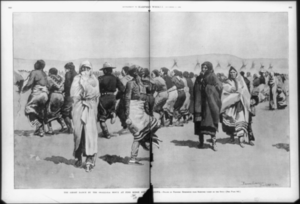
Noted in historical accounts as the Ghost Dance of 1890, the Ghost Dance was a religious movement incorporated into numerous Native American belief systems. The traditional ritual used in the Ghost Dance, the circle dance, has been used by many Native Americans since prehistoric times, but was first performed in accordance with Jack Wilson's teachings among the Nevada Paiute in 1889. The practice swept throughout much of the American West, quickly reaching areas of California and Oklahoma. As the Ghost Dance spread from its original source, Native American tribes synthesized selective aspects of the ritual with their own beliefs, often creating change in both the society that integrated it and the ritual itself.
At the core of the movement was the prophet of peace Jack Wilson, known as Wovoka among the Paiute, who prophesied a peaceful end to white American expansion while preaching messages of clean living, an honest life, and cross-cultural cooperation. Perhaps the best known facet of the Ghost Dance movement is the role it reportedly played in instigating the Wounded Knee massacre in 1890, which resulted in the deaths of at least 153 Lakota Sioux (Utley 2004). The Sioux variation on the Ghost Dance tended towards millenarianism, an innovation which distinguished the Sioux interpretation from Jack Wilson's original teachings.
Through Native Americans and some Anglo Americans, Jack Wilson’s message spread across much of the western portion of the United States. Early in the religious movement many tribes sent members to investigate the self-proclaimed prophet, while other communities sent delegates only to be cordial. Regardless of their motivations, many left believers and returned to their homeland preaching his message. The Ghost Dance was also investigated by many Mormons from Utah, for whom the concepts of the Native American prophet were familiar and often accepted (Kehoe 2006).
While most followers of the Ghost Dance understood Wovoka’s role as being that of a teacher of pacifism and peace, others did not.
An alternate interpretation of the Ghost Dance tradition may be seen in the so-called Ghost Shirts, which were special garments rumored to repel bullets through spiritual power. It is uncertain where this belief originated, although some observers such as James Mooney have argued that the most likely source is the Mormon endowment “garment” (which some Mormons believed would protect the pious wearer from danger). Despite the uncertainty of its origins, it is generally accepted that chief Kicking Bear brought the concept to his own people, the Lakota Sioux, in 1890 (Kehoe 2006).
Another Lakota interpretation of Jack’s religion is drawn from the idea of a “renewed Earth” in which “all evil is washed away.” This Lakota interpretation included the removal of all Anglo Americans from their lands, unlike Jack’s version of the Ghost Dance which encouraged harmonious co-existence with Anglos.
In February 1890, the United States government broke a Lakota treaty by adjusting the Great Sioux Reservation of South Dakota (an area that formerly encompassed the majority of the state) into five smaller reservations (Kehoe 2006). Once on the reduced reservations, tribes were separated into family units on 320-acre (1.3 km²) plots, forced to farm, raise livestock, and send their children to boarding schools that forbade any inclusion of Native American traditional culture and language.
To help support the Sioux during the period of transition, the Bureau of Indian Affairs (BIA), was delegated the responsibility of supplementing the Sioux with food and hiring white farmers as teachers for the people. The farming plan failed to take into account the difficulty Sioux farmers would have in trying to cultivate crops in the semi-arid region of South Dakota. By the end of the 1890 growing season, a time of intense heat and low rainfall, it was clear that the land was unable to produce substantial agricultural yields. Unfortunately, this was also the time when the government’s patience with supporting the so-called “lazy Indians” ran out, resulting in rations to the Sioux being cut in half. With the bison virtually eradicated from the plains a few years earlier, the Sioux had no options available to escape starvation.
Increased performances of the Ghost Dance ritual ensued, frightening the supervising agents of the BIA. Kicking Bear was forced to leave Standing Rock, but when the dances continued unabated, Agent McLaughlin asked for more troops, claiming that Hunkpapa spiritual leader Sitting Bull was the real leader of the movement. Thousands of additional U.S. Army troops were deployed to the reservation. On December 15, 1890, Sitting Bull was arrested on the reservation for failing to stop his people from practicing the Ghost Dance (Kehoe 2006). During the incident, a Sioux witnessing the arrest fired at one of the soldiers prompting an immediate retaliation; this conflict resulted in deaths on both sides, including the loss of Sitting Bull himself.
Big Foot, a Miniconjou leader on the U.S. Army’s list of trouble-making Indians, was stopped while en route to convene with the remaining Sioux chiefs. U.S. Army officers forced him and his people to relocate to a small camp close to the Pine Ridge Agency so that the soldiers could more closely watch the old chief. That evening, December 28, the small band of Sioux erected their tipis on the banks of Wounded Knee Creek. The following day, during an attempt by the officers to collect any remaining weapons from the band, one young and deaf Sioux warrior refused to relinquish his arms. A struggle followed in which somebody's weapon discharged into the air. One U.S. officer gave the command to open fire and the Sioux responded by taking up previously confiscated weapons; the U.S. forces responded with carbine firearms and several rapid fire light artillery (Hotchkiss) guns mounted on the overlooking hill. When the fighting had concluded, 25 U.S. soldiers lay dead, many killed by friendly fire, amongst the 153 dead Sioux, most of whom were women and children (Kehoe 2006).
Notes
ReferencesISBN links support NWE through referral fees
- "American Indian Contributions To Science and Technology", Chris R. Landon, Portland Public Schools, 1993
- "Buffalo and the Plains Indians", South Dakota State Historical Society Education Kit
- Carlson, Paul H. The Plains Indians. College Station: Texas A&M University Press, 1998. ISBN 0-89096-828-4
- Taylor, Colin E. The Plains Indians: A Cultural and Historical View of the North American Plains Tribes of the Pre-Reservation Period. New York: Crescent Books, 1994. ISBN 0517142503
- Kehoe, B Alice The Ghost Dance: Ethnohistory and Revitalization Thompson publishing; 1989
- Brown, Dee. Bury My Heart at Wounded Knee: An Indian History of the American West. Owl Books; 1970
- Du Bois, Cora. The 1870 Ghost Dance. University of California Press; Berkeley, 1939.
- Osterreich, Shelley Anne. The American Indian Ghost Dance, 1870 and 1890. Greenwood Press; New York, 1991.
- "Ghost Dance" (Hale, 1997) by *Adam Wright - Author, a fictional Western based on the Ghost Dance.
- Stannard, David E. American Holocaust: The Conquest of the New World. Oxford University Press; 1992
- Waldman, Carl. 2006. Encyclopedia of Native American Tribes. New York, NY: Checkmark Books. ISBN 978-0816062744
- Berlo, Janet Catherine. 1997. Plains Indian Drawings. Tribal Arts. Retrieved October 28, 2008.
- Lookingbill, Brad D. 2006. War Dance at Fort Marion: Plains Indian War Prisoners. Norman, OK: University of Oklahoma Press. ISBN 978-0806137391.
- Wong, Hertha Dawn. 1992. Sending My Heart Back Across the Years: Tradition and Innovation in Native American Autobiography. Oxford University Press. ISBN 978-0195069129.
- Berlo, Jane Catherine. 1996. Plains Indian Drawings 1865-1935. Harry N. Abrams. ISBN 978-0810937420.
- Tomkins, William. [1931] 1969. Indian sign language. New York, NY: Dover Publications 1969.
- Schwatka, Frederick. [1889] 1994. The Sun-Dance of the Sioux. Century Magazine 39: 753-759. Retrieved November 5, 2008.
- Kehoe, Alice Beck. 2006. The Ghost Dance: Ethnohistory and Revitalization. Waveland Press. ISBN 978-1577664536
- Utley, Robert M. 2004. The Last Days of the Sioux Nation. New Haven, CT: Yale University Press. ISBN 0300103166
- NBA. 2008. Byproducts: Nature's Bountiful Commissary for the Plains Indians. National Bison Association website. Retrieved November 5, 2008.
- Nowak, Ronald M. 1999. Walker's Mammals of the World. Baltimore, MD: Johns Hopkins University Press. ISBN 0801857899
- Moulton, Michael, and James Sanderson. 1998. Wildlife Issues in a Changing World. Boca Raton, FL: CRC Press. ISBN 1566703514
External links
- The Plains Indian Museum
- Plains Indian Ledger Art
- Museum of the Plains Indian
- Plains Indian Sign Language
Credits
New World Encyclopedia writers and editors rewrote and completed the Wikipedia article in accordance with New World Encyclopedia standards. This article abides by terms of the Creative Commons CC-by-sa 3.0 License (CC-by-sa), which may be used and disseminated with proper attribution. Credit is due under the terms of this license that can reference both the New World Encyclopedia contributors and the selfless volunteer contributors of the Wikimedia Foundation. To cite this article click here for a list of acceptable citing formats.The history of earlier contributions by wikipedians is accessible to researchers here:
The history of this article since it was imported to New World Encyclopedia:
Note: Some restrictions may apply to use of individual images which are separately licensed.
